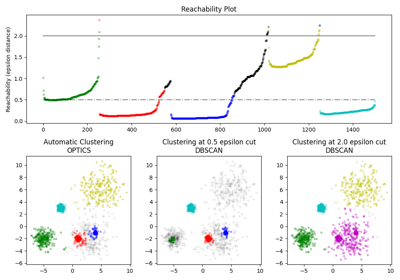sklearn.cluster.cluster_optics_dbscan#
- sklearn.cluster.cluster_optics_dbscan(*, reachability, core_distances, ordering, eps)[source]#
Perform DBSCAN extraction for an arbitrary epsilon.
Extracting the clusters runs in linear time. Note that this results in
labels_which are close to aDBSCANwith similar settings andeps, only ifepsis close tomax_eps.- Parameters:
- reachabilityndarray of shape (n_samples,)
Reachability distances calculated by OPTICS (
reachability_).- core_distancesndarray of shape (n_samples,)
Distances at which points become core (
core_distances_).- orderingndarray of shape (n_samples,)
OPTICS ordered point indices (
ordering_).- epsfloat
DBSCAN
epsparameter. Must be set to <max_eps. Results will be close to DBSCAN algorithm ifepsandmax_epsare close to one another.
- Returns:
- labels_array of shape (n_samples,)
The estimated labels.
Examples
>>> import numpy as np >>> from sklearn.cluster import cluster_optics_dbscan, compute_optics_graph >>> X = np.array([[1, 2], [2, 5], [3, 6], ... [8, 7], [8, 8], [7, 3]]) >>> ordering, core_distances, reachability, predecessor = compute_optics_graph( ... X, ... min_samples=2, ... max_eps=np.inf, ... metric="minkowski", ... p=2, ... metric_params=None, ... algorithm="auto", ... leaf_size=30, ... n_jobs=None, ... ) >>> eps = 4.5 >>> labels = cluster_optics_dbscan( ... reachability=reachability, ... core_distances=core_distances, ... ordering=ordering, ... eps=eps, ... ) >>> labels array([0, 0, 0, 1, 1, 1])

